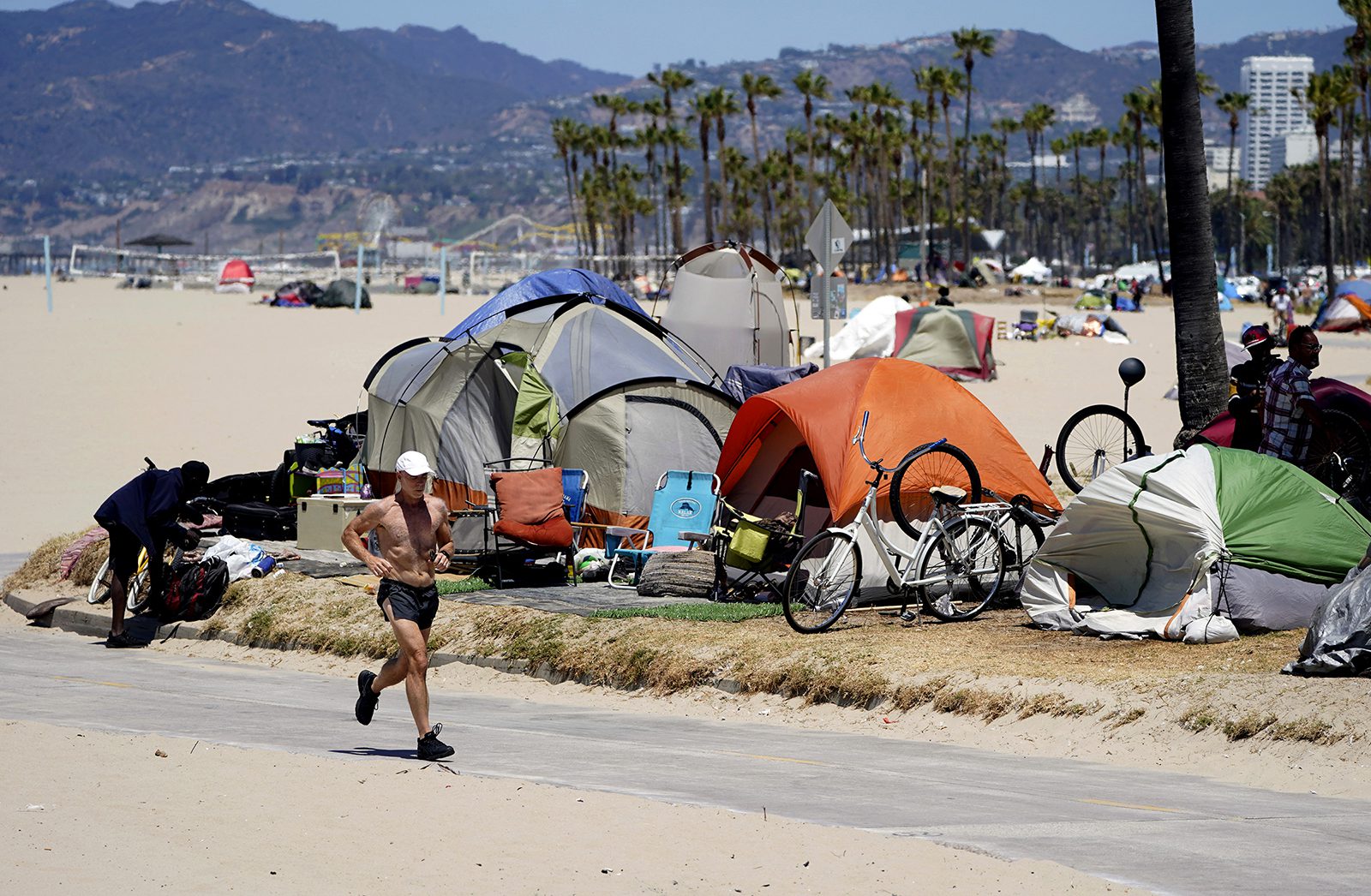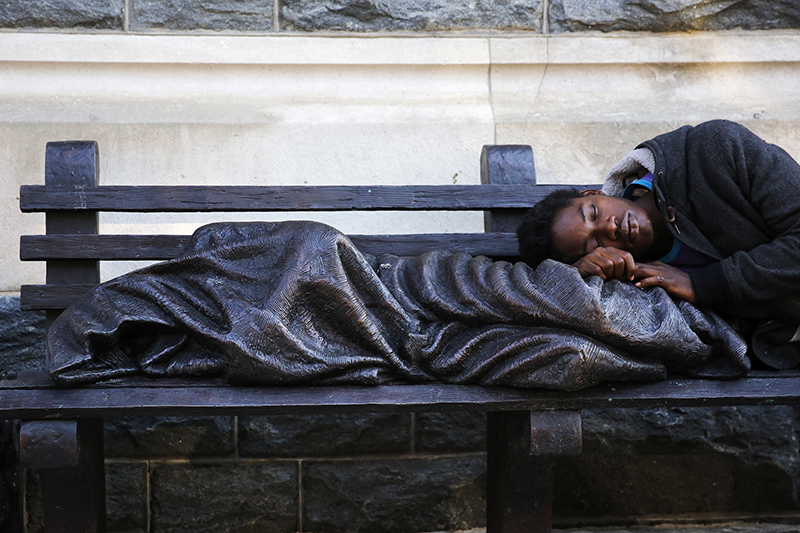(RNS) — There’s a recurring art installation I’m quite fond of. After it debuted to wide notoriety, commissions poured in from one city after the next — now nearing 100 across multiple continents. At first glance it looks like a standard bench, with a bundled-up figure lying across it — one might assume it’s simply another person experiencing homelessness and trying to get some sleep. On closer inspection, however, the figure’s dangling feet bear the signature markings of the crucified Christ.
Known simply as “Homeless Jesus,” sculptor Timothy Schmalz was inspired to create it when a similar figure, bundled for warmth and asleep on a park bench in downtown Toronto, brought to his mind the famous Scripture from Matthew 25: “Truly I tell you, whatever you did for one of the least of these brothers and sisters of mine, you did for me.”
Responses have been wide-ranging. In Ohio, one woman called the police 20 minutes after it was installed, complaining of the “homeless person on the bench.” Others have spent time sitting at this Jesus’ feet; his legs are tucked just enough to make room on the bench for one more weary passerby.
This sculpture confronts us with a frank question: How will we respond to the person on the bench?
As someone who has dedicated the past seven years of my life to understanding and ending homelessness and the factors that lead to it, I can tell you that this election season is our time to answer that question.
In nearly every major urban city, everywhere in the country, homelessness is on the ballot.
A spike in homelessness, combined with its growing visibility in the wake of the pandemic, has led to city councilpersons, sheriffs, mayors, governors, and judges all running campaigns centered on their solutions to homelessness. Most are vague on policy and overly rosy about what they can do. Most reflect deep partisan divides — as well as ignorance — about the causes of homelessness, its connection to crime and public safety and the policies they believe will solve it.
Campaigns promise “cleaner” or “safer” streets, which trade on misconceptions and animosities about homelessness that are based in fear and not fact. Some ballot measures aim to fund services and shelters. Others seek to criminalize survival skills — for example, sleeping on benches — that are both essential and unavoidable for folks stuck on the street.
Cities like Los Angeles, Portland, Nashville and New York City have recently shifted toward increased criminalization under current leadership. Voters elsewhere will soon have to decide whether to hop on this bandwagon or forge another path.

A jogger runs past a homeless encampment in the Venice Beach section of Los Angeles on June 8, 2021. (AP Photo/Marcio Jose Sanchez, File)
Unfortunately, as many of these cities are newer to homelessness as a major political issue, and their voters unacquainted with the shifty political language around homelessness, things can get confusing. Many candidates and proposed policies employ positive-sounding language such as “helping” and “compassionate response,” yet in practice they rarely resemble anything like it.
Take Kansas City, where a task force headed by Mayor Quinton Lucas recently unveiled “Zero KC,” a five-year plan to “end the growing problem of homelessness in Kansas City.” The four components of the plan, however, offer little to deliver on its stated promise. The plan is limited to building emergency shelters, extreme weather contingencies, a job program for 15 people, and a community-needs assessment. Many cities share this urge to build shelters, even though we know shelters do not end homelessness so much as they move it out of sight (not to mention the typical combination of strict rule enforcement, poor living conditions and tight quarters that leave many opting for the streets instead).
So how do we cut through the noise and make the right decisions about how to vote?
Matthew 25 may inspire us like it did Timothy Schmalz. If we take Jesus to mean that our treatment of our unsheltered neighbors reflects our regard for him, we might consider spending more time listening to them than talking about them.
The “community-needs assessment” Kansas City proposes is on the right track (though, ironically, they admit that they already undertook a similar process and received recommendations for housing and hygiene facilities, neither of which have been incorporated into this latest plan). Too often, even in heeding Jesus’ call in Matthew 25, we fall into the trap that tells us serving the poor is a call to push our ideas, our presuppositions to the forefront. When our best-laid plans do what best-laid plans do best, we insist our methods were sound. It was they who should have listened to us.
As it concerns the midterms, listening to the needs of the unhoused means voting in ways that benefit their lives directly for needs they are articulating. While this will differ widely from place to place, a few things are clear: People experiencing homelessness want housing, not more shelters; they want solutions, not sweeps (clean-ups that displace them and destroy their property).
Not all candidates or policies fall so obviously into these categories, and for many of us it may be too late to develop the robust relationships it takes to vote in solidarity with the unhoused. In this case, I recommend looking to local advocacy groups for their voting guides. Nearly every major city has local groups doing hands-on outreach and advocacy, and they are often well-versed in these things. (While you’re at it, volunteer with them, too!)
If we don’t approach our unhoused neighbors in the way we would Jesus — with hearts and minds open, ready to partner rather than lead and eager to put into practice what we’re taught — how far from Jesus must we really be?
Just as the “Homeless Jesus” sculpture insists, there is room to sit at the feet of those experiencing homelessness, to leave changed and to take what we’ve experienced into the voting booth and improve our communities for every resident, indoors and out.
(Kevin Nye is the author of “Grace Can Lead Us Home: A Christian Call to End Homelessness.” The views expressed in this commentary do not necessarily reflect those of Religion News Service.)





